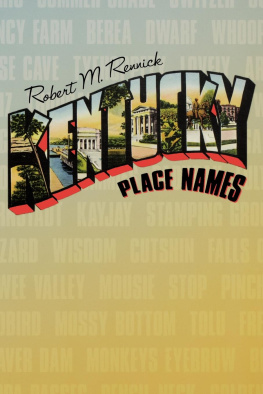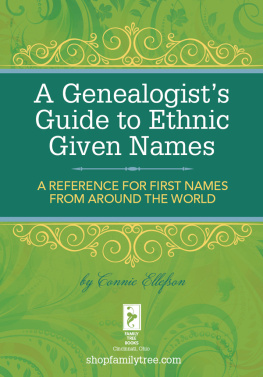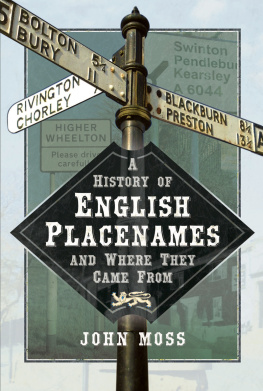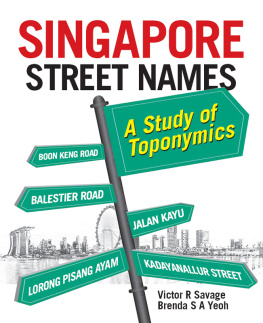


Published by
World Scientific Publishing Co. Pte. Ltd.
5 Toh Tuck Link, Singapore 596224
USA office: 27 Warren Street, Suite 401-402, Hackensack, NJ 07601
UK office: 57 Shelton Street, Covent Garden, London WC2H 9HE
National Library Board, Singapore Cataloguing in Publication Data
Names: Ng, Yew Peng, 1946
Title: Whats in the name? : how the streets and villages in Singapore got their names / Ng Yew Peng.
Description: Singapore : World Scientific, [2017]
Identifiers: OCN 990571127 | 978-981-32-2139-0 (paperback) | 978-981-32-2135-2 (hardcover)
Subjects: LCSH: Street names--Singapore--History. | Names, Geographical--Singapore--History. |
Singapore--Name--History.
Classification: DDC 915.9570014--dc23
British Library Cataloguing-in-Publication Data
A catalogue record for this book is available from the British Library.
Copyright 2018 by World Scientific Publishing Co. Pte. Ltd.
All rights reserved. This book, or parts thereof, may not be reproduced in any form or by any means, electronic or mechanical, including photocopying, recording or any information storage and retrieval system now known or to be invented, without written permission from the publisher.
For photocopying of material in this volume, please pay a copying fee through the Copyright Clearance Center, Inc., 222 Rosewood Drive, Danvers, MA 01923, USA. In this case permission to photocopy is not required from the publisher.
Desk Editor: Tay Yu Shan
Typeset by Stallion Press
Email:
Printed in Singapore
ABOUT THE AUTHOR
Ng Yew Peng came to Singapore from Nan An County of Fujian Province, China, at the age of 11. He was awarded the Overseas Scholarship under the Colombo Plan and graduated with a Degree in Mechanical Engineering from the University of Canterbury, New Zealand. He returned to Singapore and worked as an engineer in the Civil Service and various commercial organisations. From 1994 to 1998, he was stationed in Shanghai. After his retirement, he pursued further studies in Chinese Language and Literature at Peking University and the University of Nanjing in China. The first part of this book is an adaptation of his graduation thesis for the Master of Arts degree from the University of Nanjing.
The paintings on the front cover and inside the book were works of art by the late Mr. Chua Ek Kay and are now properties of his wife. Reproductions in any form requires written permission from Mrs. Chua Ek Kay (Mdm Yeo Yang Kwee).
This book is supported by
The author is grateful to the National Heritage Board for its financial support towards the printing of this book. However, the views expressed here are solely those of the author in his private capacity and do not in any way represent the views of the National Heritage Board and/or any government agencies.
CONTENTS
PART I
A STUDY OF SINGAPORE
PLACE NAMES
SECTION 1
INTRODUCTION
A place name is the specific label of a geographical entity. It may represent the location of the geographical entity, its genre, or its physical or geographical characteristics. From a literary perspective, place names are the products of a societys socio-economic and cultural history and its development; thus, they reflect the particular characteristics of that society at certain moments in time. Because place names are not frequently changed, they can preserve historical and cultural information for long periods of time.
Singapore was originally known as Temasek/Tumasik (meaning water-town in Javanese). According to local legend, a Sumatran Prince named Sang Nila Utama was sailing from Riau Island when a strong wind swept his boat to a small island. There, he saw a lion and subsequently named the island Singapurasinga means lion and pura means city. This was the origin of the name Lion City, as Singapore is otherwise known today.
Singapore has many historical names. On a nautical map drawn by J C Bellin in 1755, it was called Pulau Panjang (which means long island in Malay). Early records from 14th century China identified the island using various transcriptions of the Malay names Temasek and Selat, or the Chinese names Long Ya Men or Ling Ya Men, meaning dragon tooth gate. The dragon tooth was a huge rock in the sea off the beach of Labrador as well as a shipping landmark. It was later called Lots Wife by the British and was blown up in August 1848. The name of the island was changed to Singapore after Britain took control of the island in 1819.
Development of the island began almost immediately; by 1823, a town plan had been drawn up. Early street names can be seen on a map drawn by G D Coleman, which was based on an actual survey conducted in 1829 and published in 1835. In addition, two lists of Street and Road Names in Singapore were published in The Straits Times in 1853.
The first study of Singapores place names was written by H T Haughton. His list of 73 place names was published in Volume 20 of the Journal of theStraits Branch of the Royal Asiatic Society in 1889. This was followed by a list of 225 colloquial Chinese place names compiled by H W Firmstone in Volume 42 of the same journal in 1905.
The first official publication on Singapore place names was the Singapore Gazetteer-Index to Roads, 1936. This was an alphabetised table of place names published by the Survey Department of the Straits Settlements. After World War Two (WW2), the Survey Department published three editions of its Road and Street Directory between 1950 and 1953. The more familiar Singapore Street Directory was introduced in 1954. It divided Singapore into 115 small sections and provided a detailed map of street names for each section. All the above publications were only produced in English.
The first book on Singapores toponyms, Malayan Street Names, was produced by Raja Singam. It was published in 1939 and contained notes on nearly 500 place names in Singapore. Unfortunately, a comparison between this book and primary records revealed many discrepancies in the sources of street names.
Next was a Chinese publication Record of Place and Street Names inSouth East Asia by Phua Chay Long, also published in 1939. In a revised edition in 1952, the author listed 1,600 place names in English and Chinese, along with a map of the city.
The first complete Singapore street directory in the Chinese language, titled Singapore Guide and List of Street Names was published in 1967. It was compiled by Lee Kian Chye based on the eighth edition of the official Singapore Street Directory. It contained street names in both English and Chinese as well as information on places of interest. Most of the Chinese street names listed in this book were the official versions taken from the road signs posted along the streets. However, it quickly became obvious that the Chinese translations of street names lacked uniformity and were sometimes arbitrary. This situation had resulted from the use of Chinese colloquial street names for some streets; in many cases, colonial officials had also made inappropriate selections of Chinese words.















